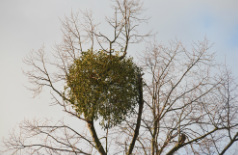| Mistletoe, Phoradendron - the scientific name for American mistletoe, means "thief of the tree" in Greek. Although not a true parasite in scientific terms, mistletoe comes close, sinking its roots into a host tree and leeching nutrients from the tree to supplement its own photosynthesis. Sadly, the translation of the word “mistletoe” itself isn’t very romantic. A few centuries back, some people apparently observed that mistletoe tended to take root where birds had left their droppings. “Mistal” is an Anglo-Saxon word that means “dung” and “tan” means “twig,” so mistletoe actually means “dung on a twig.” |
The growth of mistletoe had little to do with the bird droppings, and a lot to do with the birds themselves. Mistletoe seeds are extremely sticky and often latch onto birds’ beaks or feathers or the fur of other woodland creatures, hitchhiking to a likely host tree before dropping off and starting to germinate. Mistletoe is toxic to people, but the berries and leaves provide high-protein food for many animals.
Application: Mistletoe attaches itself to various trees, drawing from their supply of sap to carry on its own growth. In return it gives nothing. It is a one-sided, vary selfish arrangement. Never be like the mistletoe.
Application: Mistletoe attaches itself to various trees, drawing from their supply of sap to carry on its own growth. In return it gives nothing. It is a one-sided, vary selfish arrangement. Never be like the mistletoe.

 RSS Feed
RSS Feed
